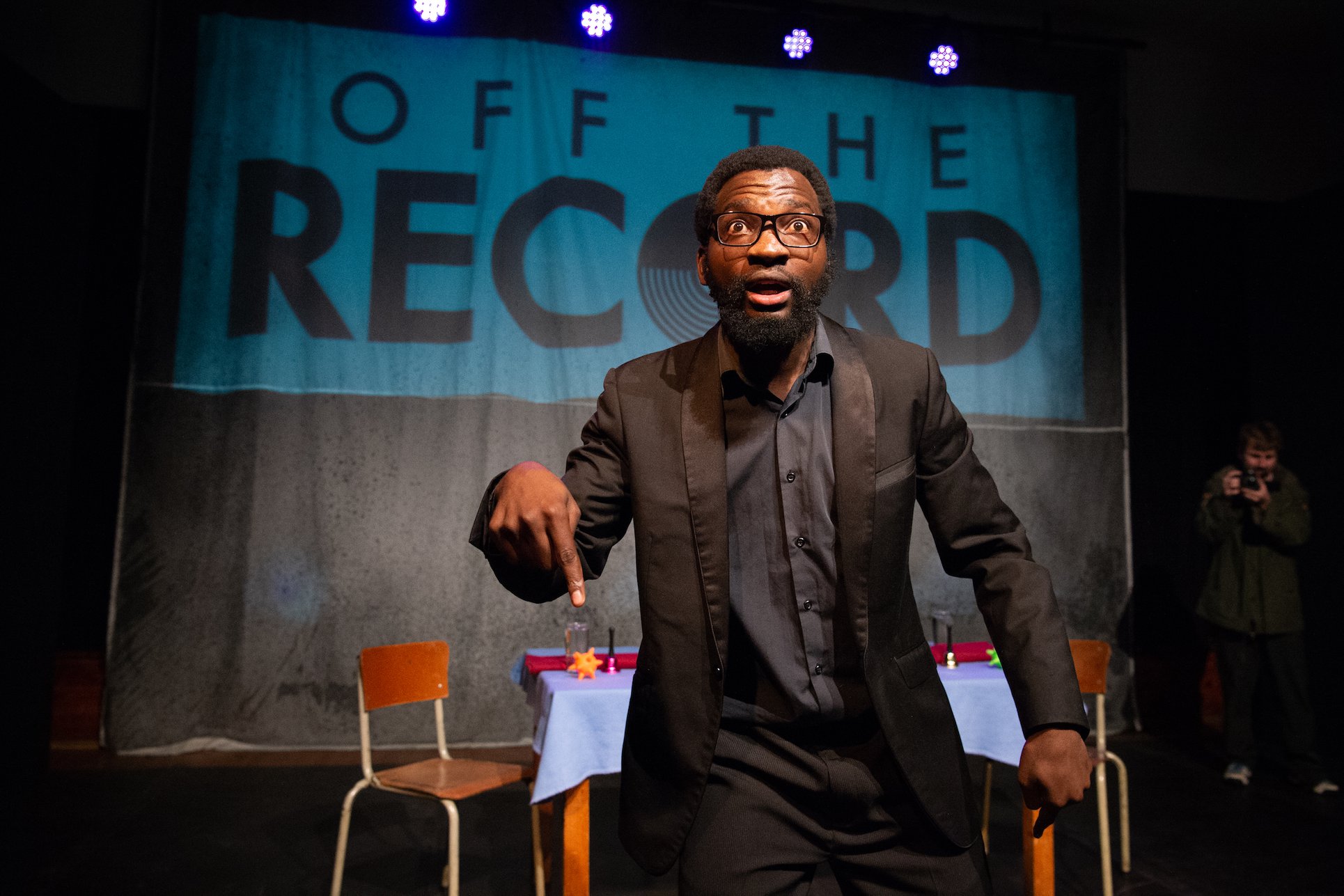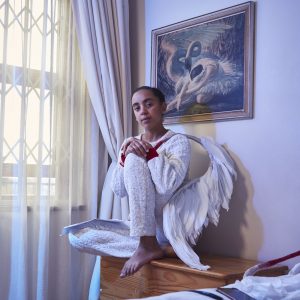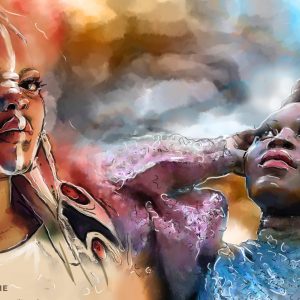The arts delivered in pixels and bytes
The past, present and future collided powerfully at this year’s National Arts Festival, which bore the signature of our times as subjugated voices took centre stage.
Author:
17 July 2020

At some point during early July’s rectangular-eyed blur, singer Gabi Motuba resurrected the ghosts left behind by colonial oppression and plundering.
They were joined by the spirits of a liberation democracy’s contemporary failures, made acute by the global Covid-19 pandemic. These are spectres of a marginalised people going hungry during the state’s strict lockdown, of inept government politicians failing ordinary folk, rampant state corruption leading to the death of innocent people, of the City of Cape Town’s anti-land invasion unit brutalising a naked Bulelani Qholani and of soldiers murdering an innocent Collins Khosa.
“The unemployed man. The starving native. Half natives. Non-humans … the children of violence,” Motuba sang as The Wretched’s other members, drummer Tumi Mogorosi and guitarist and sound artist Andrei van Wyk, built a swarm of rage around her vocals. This was the music of psychological breakdown and broken black bodies, of traumatic memory and Frantz Fanon’s postcolonial warnings.
Complete immersion was tantalisingly close. But it was buffered by bandwidth.
Related article:
The images and the music stuck – on the computer. The swirl of sound was replaced by the circular sign of all too slow, all too expensive internet. The moment remained, but not as it was.
The 45th edition of the National Arts Festival was always going to be fraught with difficulties once the coronavirus pandemic made clear that South Africans would not be able to gather in the Eastern Cape town of Makhanda for its annual showcase of music, theatre, art, dance, comedy, literature and panel discussions – a reflection, in the arts, of what the country is thinking and feeling.
For the organisers of the festival it meant, after President Cyril Ramaphosa’s announcement of a lockdown in March, reworking an almost finalised programme of events. It demanded imagination and agility to curate a shift from mainly live performances to work that could be adjusted, filmed and then presented on the internet. Or new work that used the online medium and the possibilities it offered in concept and practice to create something fresh for this year’s virtual National Arts Festival.

Scratching at scabs
The former was most evident in pieces such as Standard Bank Young Artist for Theatre Jefferson Tshabalala’s edgy J. Bobs Live – Seen Pha kwa J.B!. The performance used rap, beat-boxing and acting to take the audience through a series of hilarious episodes that scratch at the scabs of race relations in society and consumerist cultural production, among other themes. Performed (and filmed) in a studio that is both stage and set, it blurred the lines between theatre, television and reality with insouciance.
Online-specific work included Leila Anderson and Stan Wannet’s Screen Saver, which used the medium of the computer to create an artwork that required a patience increasingly anathema to the hi-tech instant gratification norms of our age. Touch your mouse and the artwork is disrupted, leave it alone and it reveals itself over 10 minutes.
Marcio Carvalho’s Who Do We Come to H(a)unt, meanwhile, allowed people to wreck-claim bronze statues ranging from Joseph Stalin and Belgium’s King Leopold II to the horrendous Nelson Mandela bronze in Sandton, Johannesburg. The interactive art project allows users to digitally wreck drawings of existing statues to tell alternative stories about old, hegemonic histories. It tapped into current conversations within the Black Lives Matter movement and others about what to do with the bronzed memorialisation of racism and slavery that have become everyday sites of trauma in the public’s eyeline.

Lockdown alienation
For punters, this shift to a virtual festival meant logging in to rather than trekking out to the stages, galleries, markets, street stalls, pop-ups, bars and restaurants that make the festival. A shift that sometimes deepened a sense of lockdown alienation, of being alone, because it highlighted so starkly what had been lost: the joyous magic of the live experience and its ability to invoke immersion, meditation, rumination; the individual act of attendance converted into a communion; the shared experiences and spontaneous responses within that concord, which lingers long after the performance ends; the provocations inherent in the engaged work that cause passionate, boozy debate at the Long Table until just before sunrise; and, just maybe, some solidarity and action.
This all disappeared. To be replaced by a buffering sign, the WhatsApp ping, a household in the background – all intrusions into interaction. Where previously one’s eyes and attention had the freedoms of engagement, that experience was now mediated by cinematographers, directors and editors. Reflection on work became more solitary and lonely.
This is, obviously, not the festival’s fault, merely the signature to our times.
If anything, the adversities it faced appear to have strengthened the festival. An online marketing legacy of a virtual Village Green and a virtual Fringe, which will run until 31 July, have been a result of the online migration. The latter allows artists who have suffered financial loss during the pandemic’s prohibition of live performances to earn some income over a longer period.
Amplifying historically marginalised voices
Moreover, the curatorial difficulties presented by the online platforms did not undermine the standard of work presented. Adaptation to a “new normal” – for however long it threatens to last – made for provocative, challenging work that in several cases amplified this moment’s requirement to listen to voices that have been historically marginalised, ignored or subjugated. This was especially so for black female artists on the curated programme.
Festival artistic director Rucera Seethal emphasised the importance of facilitating and ensuring the presence of women at the festival as many, especially single mothers, had the additional, sole task of home-schooling children over the production period.
The curated programme included Standard Bank Young Artist for Dance Lulu Prudence Mlangeni, who returned to her Soweto hood for a documentary, Lesedi: The Rise of Lulu Mlangeni.
The film brought together autobiography and dance, her life and her life’s work, to explore the anti-black, anti-female milieu she had to fight against and rise above. The personal-political nature of the documentary meant that, thematically, it fitted into a body of work that includes Question Mark and Confined, two earlier pieces that examined the life of Winnie Madikizela-Mandela, a figure too often cast in black and white rather than the shades of nuance in which she ought to have been held.

For those hankering after “Grahamstown”, Qondiswa James’ semi-autobiographical theatre piece, A Howl in Makhanda, explored the hypocrisy inherent in the exclusionary identity of a “frontier town” characterised by posh private schools, the university currently known as Rhodes University, 1820 colonial settlers and their farmer descendants.
Set in Makhanda’s elite Diocesan School for Girls, it follows four teenagers – two black and two white – through a schooling system that one of them aptly describes as “part of a plan to make [us into] a dutiful machine for capitalism, hardwired for conformity”.
The daily routines of boarding school life, attending classes, shit-talking and smoking cigarettes are punctured by conversations about the culture of body shaping and shaming in these institutions where racism is rife. Also explored is the sexualisation of young girls in broader society and themes of depression, bulimia, white privilege and rape culture.
The different outcomes reserved for two of the main characters – one black, the other white – when both are found guilty of the same transgression not only exposes the racist hypocrisies at the school but also those in a South Africa where the rainbow nation project is failing, because it asks so much of black people and so little of whites.
A razor-sharp script that references Sylvia Plath and Kurt Cobain combined with fine acting, directing and cinematography ensures a powerful and essential piece of filmed theatre.
Delving deeper into Feni and freedom
Dumile Feni: Four Provocations gathered four of the continent’s premier dancers and choreographers: Zimbabwe-born and New York-based Nora Chipaumire, 2018 Standard Bank Young Artist for Performance Art Chuma Sopotela, British-Rwandan Dorothée Munyaneza and Ivorian Nadia Beugré. Their performances consider the work, and life in exile, of South African visual artist Dumile Feni.
The programme promised a “sidestepping” of a “prosaic reinterpretation of another artist’s work” to “delve deeper into aspects of Feni’s life, aspects that resonated with [the artists] – the ache of and for home, a preoccupation with music from the motherland, creating art in poverty, the paradox of exile – that bring us closer to understanding Feni, the artist and the human”.
The artists delivered work of staggering power and feminist revisionism that will be developed individually for the festival and the Institute for Creative Arts.
In (another) township manifesto, Chipaumire considered the lionisation of male freedom fighters while their female counterparts, or even the women they leave behind to deal with the politics of the everyday, are cast into the shadows. She examined the lonely pain of exile and its consequences, all set to a blistering soundtrack that included Zimbabwean artists Thomas Mapfumo and The Blacks Unlimited, Dorothy Masuka and Nigerian Sonny Okosun’s Fire in Soweto.
Related article:
Sopotela’s work, A Short Tribute to Zwelidumile Geetbooi Mgxaji Mhlaba ‘Dumile’ Feni was performed and filmed within the claustrophobia of a square no larger than a small, four-walled shack. Instead of corrugated metal and castaway wood, the walls were made of blankets of uniform colour and design, the blanket of the matriarchy, poverty, defence, rural nostalgia, warmth and protection.
Sopotela’s room was furnished with nothing more than a shovel, potjie pot, bar heater and storage chest. All these props were used evocatively as parts of the performance and filming process.
“I woke up to a thought that I should build a grave” are the words that hung over the piece as Sopotela awakened with blackened, puffy eyes that bore a deep violence that stretched back centuries. Her performance raised questions about creating art in poverty, but also examined contemporary themes such as the anxiety around death and burial during this time of the pandemic.
Madonsini speaks to the spiritual and everyday
The featured artist at this year’s festival was Madosini Manqina, the septuagenarian guardian of traditional Xhosa music from the Pondoland area of the Eastern Cape. A maestra of the umrhube (mouth bow), uhadi (music bow) and isitolotolo (jew’s harp), Madosini is an internationally lauded world music icon whose work speaks to both the spiritual and the everyday, material aspects of the human condition.
For the length of the festival’s 11 programmed days, mini documentaries of around 10 to 15 minutes were released daily. Each episode centred on one of Madosini’s songs as it traversed her life from a teenager playing the umrhube in the reeds of Pondoland as part of the initiation ritual for young girls to international acclaim.
The lockdown restricted more recent filming, but archival footage from festivals including Poetry Africa in Durban and Womad in Reading nonetheless imbued the short films with a gorgeous sense of performance and personal insight.
One of the most powerful moments in this series is when Madosini develops a personal and musical connection with Zanzibar Taarab and Unyago icon, Bi Kidude, at the Dhow Countries Music Academy in 2004.
Kidude died in 2013 at an estimated age of 103, but the 2004 interaction crystallises what towering continental giants these two musicians are as they bond over music and mischief. Their musical genealogies both trace back to spaces of mating and initiation, slavery, dispossession and oppression.
As a theme powerfully and palpably present throughout this year’s festival, it emphasised that despite man’s most violent attempts to subjugate female voices, these most eloquent guardians of our past and present remain essential to our collective futures.
The curated main programme of the Standard Bank Nationals Arts Festival and the Fringe performances continue online until 31 July.


